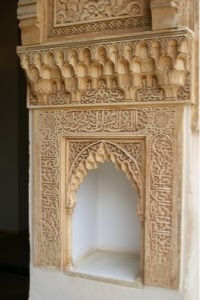So how did he talk me into it? Well, this is Dubai, and the Burj Khalifa is the tallest building and structure in the world. At 830 metres it is 200 metres higher than Mt Dandenong! But what sold me was the fact that you can do the building in a high speed elevator that takes only seconds to take you the 124 floors to the viewing station and apparently you hardly feel like you are moving. Many weeks ago I chatted with work colleague Phil, who spent six months in Dubai, about what to do while here and he highly recommended the view from Burj Khalifa at sunset. What we did not know then was that this week is Eid al-Adha, the Feast of the Sacrifice, and Dubai is packed with people enjoying the festival, so when we went to book online for a sunset viewing we should not have been surprised to find it booked-out. What did surprise is that it was booked-out all day, from 7.00am. Always looking for an opportunity Tom decided this left the door open for the alternative option - sunrise. So we set the alarm for 5.00am and headed out after a hasty shower and no breakfast to greet the sun. The lift ride was, as promised, quick and I hardly felt any movement. We joined many other early risers on the viewing platform and gasped audibly like everyone else when the first sliver of sunrise peaked over the horizon.
Eid al-Adha
The origins of this important Islamic festival are biblical and relate to the story of Abraham who was asked by Allah to sacrifice his most treasured possession, his only son. Abraham submitted to Allah's will and offered up his son for sacrifice, but Allah is merciful and at the last minute substituted an animal for the son. And from this story Muslims have developed the tradition of sacrificing a goat or sheep to commemorate Eid al-Adha. One of the less known traditions linked to this Eid is the importance of wearing new clothes - I have no idea where this tradition sprung from but I can assure it is one that Dubai's shopping culture has latched onto. The shopping centres have extended shopping hours, with the Dubai Mall, the one with the aquarium in the middle, being open 24 hours. And I have been making sure that we have been getting maximum value out of the extended shopping hours.
5 ***** luxury
We have stayed in some great accommodation on this holiday, a central Parisian apartment, a French chateau, lovely old villas in Spain and Morocco, an ancient Pyrenees fort and a boat on the Costa Brava. And now in Dubai we are staying in 5 star luxury. The Radisson is a peg or two down from some of the hotels in Dubai, but it is pretty schmick and, while it does not have the charm or character of some of the smaller establishments we have been in, we are enjoying all the facilities of a modern hotel.
I have only one complaint. The scales in our room seem to be wrong - I can't possibly have put on five kilos in five weeks. Can I ?



















































